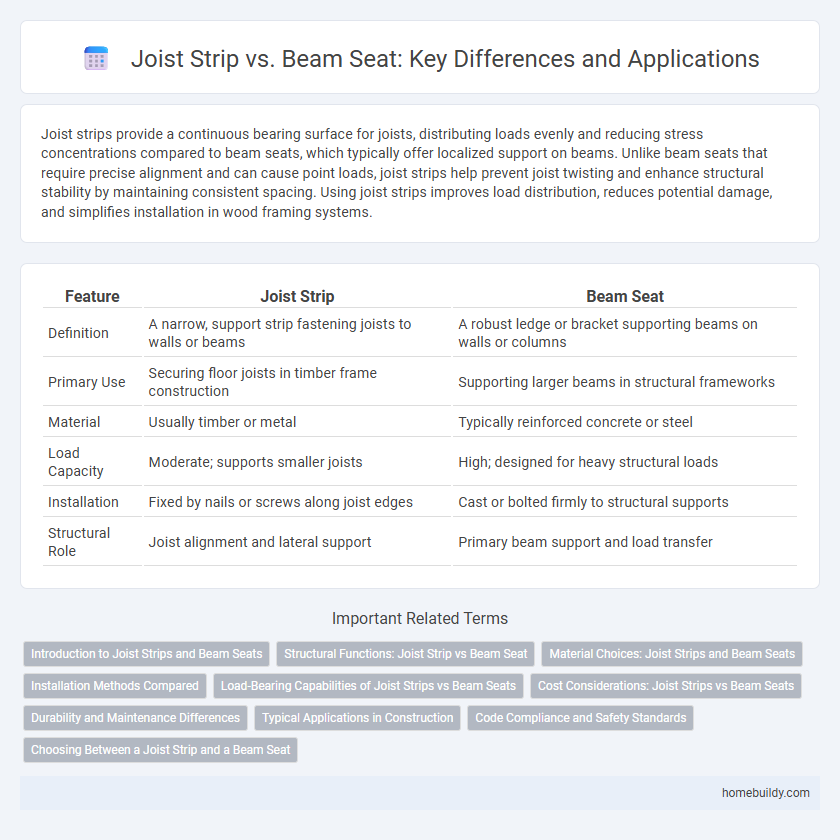Joist strips provide a continuous bearing surface for joists, distributing loads evenly and reducing stress concentrations compared to beam seats, which typically offer localized support on beams. Unlike beam seats that require precise alignment and can cause point loads, joist strips help prevent joist twisting and enhance structural stability by maintaining consistent spacing. Using joist strips improves load distribution, reduces potential damage, and simplifies installation in wood framing systems.
Table of Comparison
| Feature | Joist Strip | Beam Seat |
|---|---|---|
| Definition | A narrow, support strip fastening joists to walls or beams | A robust ledge or bracket supporting beams on walls or columns |
| Primary Use | Securing floor joists in timber frame construction | Supporting larger beams in structural frameworks |
| Material | Usually timber or metal | Typically reinforced concrete or steel |
| Load Capacity | Moderate; supports smaller joists | High; designed for heavy structural loads |
| Installation | Fixed by nails or screws along joist edges | Cast or bolted firmly to structural supports |
| Structural Role | Joist alignment and lateral support | Primary beam support and load transfer |
Introduction to Joist Strips and Beam Seats
Joist strips provide a narrow, continuous support along walls or beams for floor joists, enhancing structural stability and load distribution. Beam seats are precast or formed ledges designed to bear the weight of beams by providing a direct bearing point on columns or walls. Unlike beam seats, joist strips primarily support smaller members and are integral in framing systems where uniform joist alignment and load transfer are critical.
Structural Functions: Joist Strip vs Beam Seat
Joist strips provide direct bearing support to joists by distributing loads evenly across the supporting structure, reducing stress concentrations and enhancing stability. Beam seats function as recesses or ledges built into walls or columns to securely hold beams in place, ensuring proper load transfer from beams to vertical supports. Both elements are critical in structural frameworks, with joist strips optimizing joist alignment and load dispersion, while beam seats anchor beams and facilitate vertical load transmission.
Material Choices: Joist Strips and Beam Seats
Joist strips are typically made from galvanized steel or stainless steel, offering corrosion resistance and durability suited for supporting floor joists. Beam seats often utilize heavy-duty steel or sometimes cast iron, designed to bear higher loads and provide robust beam support. Material selection hinges on structural requirements and environmental exposure to ensure long-lasting performance and safety in construction applications.
Installation Methods Compared
Joist strips are installed by nailing or screwing directly onto the supporting structure, providing a simple and quick fastening method that ensures consistent joist spacing. Beam seats require more precise measuring and alignment, often necessitating additional hardware like brackets or ledgers for secure attachment. The installation of joist strips typically reduces labor time and complexity compared to beam seats, making them a more efficient choice for framing projects.
Load-Bearing Capabilities of Joist Strips vs Beam Seats
Joist strips provide enhanced load-bearing capabilities by distributing weight evenly across the joist, reducing stress concentrations and increasing structural stability compared to beam seats. Beam seats primarily support vertical loads at specific points, potentially leading to higher localized stress and reduced overall load distribution. The improved load transfer efficiency of joist strips makes them ideal for applications requiring robust support and minimized deflection under heavy loads.
Cost Considerations: Joist Strips vs Beam Seats
Joist strips generally offer a more cost-effective solution compared to beam seats due to lower material and installation expenses. Beam seats require additional reinforcement and heavier materials, increasing overall project costs. Selecting joist strips can optimize budget efficiency without compromising structural integrity in many framing applications.
Durability and Maintenance Differences
Joist strips offer superior durability compared to beam seats due to their ability to evenly distribute loads, reducing stress concentrations that cause wear. Maintenance requirements for joist strips are minimal, as their design prevents water accumulation and corrosion, unlike beam seats which often require frequent inspections and corrosion control. The enhanced longevity and reduced upkeep of joist strips make them a cost-effective choice for structural support in both residential and commercial construction projects.
Typical Applications in Construction
Joist strips are commonly used to provide lateral support and load distribution for floor joists in residential and light commercial construction, ensuring stability and preventing joist rotation. Beam seats serve as structural supports for heavy beams in bridges, industrial buildings, and large-scale frameworks, facilitating load transfer to columns or walls. Typical applications highlight joist strips in floor framing systems, while beam seats are essential in heavy structural steel and concrete beam installations.
Code Compliance and Safety Standards
Joist strips provide superior code compliance by ensuring proper load distribution and structural stability in accordance with International Building Code (IBC) standards. Unlike beam seats, joist strips reduce the risk of lateral movement and deflection, enhancing safety during seismic or heavy load conditions. Their installation aligns with ASTM E72 testing requirements, confirming reliable performance under stress.
Choosing Between a Joist Strip and a Beam Seat
Joist strips offer a lightweight, cost-effective solution for securing floor joists directly to beams, ideal for residential construction where speed and budget are priorities. Beam seats provide a more robust and durable support, essential for heavy loads and commercial projects requiring enhanced structural integrity. Selecting between a joist strip and a beam seat depends on load requirements, installation complexity, and long-term performance expectations.
Joist strip vs Beam seat Infographic

 homebuildy.com
homebuildy.com